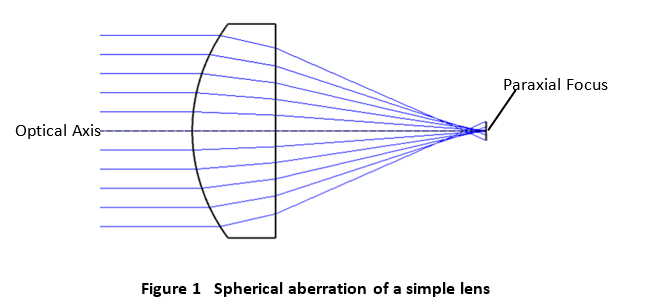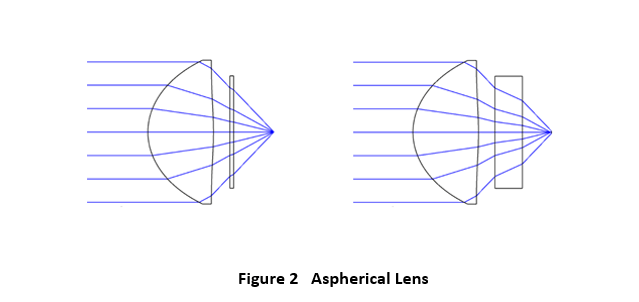Spherical aberration is one of the most common types of optical aberrations and can be defined as the variation of focus position with light ray height or distance from optical axis. Ideally, an aberration-free lens direct all light rays to a common focal point for a focusing lens or produce a perfect image for an imaging system. Spherical aberration presented in an optical system affects the image clarity or focus spot size.
Spherical aberration can be introduced into an optical system when the lens is not designed to properly correct the spherical aberration or a lens is not working under the ideal or designed conditions such as window glass thickness changed, immersion medium changed, etc.
A simple lens with undercorrected spherical aberration or negative spherical aberration forms an image of a point object which is usually a bright dot surrounded by a halo of light. Figure 1 is a sketch of a spherical singlet lens with a spherical surface which produces negative spherical aberration. The spherical aberration causes that the focal location changes with the light ray height. The rays close to the optical axis or lens center focus (intersect the axis) near paraxial focus position. As the ray height increases, the position of the ray intersection with the optical axis move further and further from the paraxial focus. The marginal rays focus closer to the lens than the paraxial rays.

The presence of spherical aberration results in a lens that cannot bring all light rays into the same focus. An imaging lens with a large amount of spherical aberration cannot form a good image at a large aperture but may get sharper images at smaller apertures.
Figure 2 shows an aspherical lens and a thin plate. Spherical aberration of the aspherical lens is corrected based on a use of a thin glass plate. All the light rays at different radial distances from the lens center focus at the same location when a thin glass plate is used. When replacing the thin glass plate with a thick glass plate, the marginal rays focus further to the lens than the rays close to the optical axis of the lens.

Spherical aberration correction is important for all high-performance systems. A vision system or imaging system with uncorrected spherical aberration cannot produce a high-resolution image. When designing an optical system, designers must consider all the optical components including windows in the system and minimize spherical aberration and other aberrations including chromatic aberration.
Most objective lenses are corrected for a thin cover glass and camera lenses are corrected for a thin sensor window. It is important to keep this in mind to avoid unintentional introduction of spherical aberrations when using off-the-shelf lenses for high-resolution imaging applications.